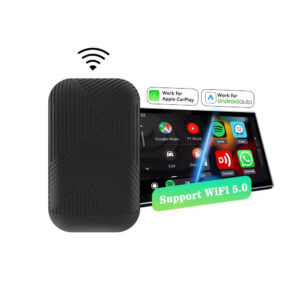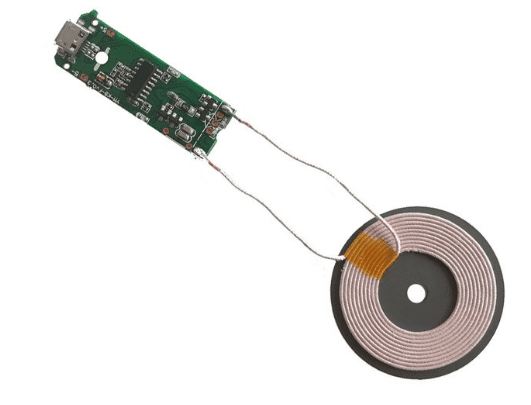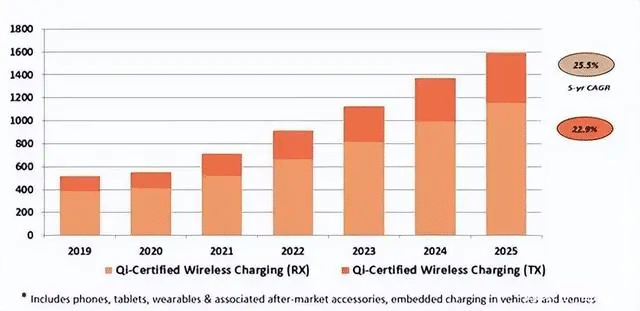Wireless Charging For Your Mobile Phone

What is Wireless Carplay adapter?
Regarding the Wireless CarPlay adapter, let’s first understand CarPlay. What is Carplay? In the center console of a car, there
In recent years, more and more mobile phone wireless chargers have entered our field of vision. When you see such a disc base that can charge mobile phones without wires, do you feel that science and technology are amazing, and How do wireless phone chargers work? Let me take you to find out!
The principle is very simple, that is, “electricity produces magnetism, magnetism produces electricity” or “electromagnetic induction”.
Wireless charging technology allows electronic devices to receive power wirelessly from a specific charger or charging station. This technology typically uses a method called magnetic field induction to create an electromagnetic field between the charger and the electronic device. When the electronic device is placed on the charger, it can then receive power wirelessly.
The electric principle of wireless charging is “electromagnetic induction” discovered by a man named Michael Faraday in 1831. Electromagnetic induction is a kind of interconnection and conversion relationship between magnetism and electricity, which provides the theoretical support for wireless charging technology.
As early as 1894, Nikola Tesla showed the world this wireless charging technology, using the magnetic field generated by the two circuits to transmit current through the air. The current wireless charging technology for cell phones is also based on this development.
In simple terms, the transmitter side of the wireless charger, converts electrical energy into magnetic energy, and the receiver side of the wireless charging of cell phones, converts the magnetic energy into electrical energy to charge the phone. The principle of wireless charging technology is very simple. However, efficient cell phone wireless charging technology, still belongs to the high-tech range, the difficulty of this technology is how to improve the charging efficiency.
When the wireless charging base is removed, all you can see are circles of coils, and the range of this coil is very large, which is also to better contact the mobile phone with the wireless charger, so as to form the purpose of charging!
The picture below is the coil inside the wireless charging. By using the magnetic field generated between the coils, the magical transmission of electric energy, the inductive coupling technology will become a bridge connecting the charging base station and the device. The combination of the things in the picture below is called the wireless charger module transmitter receiver

Mobile phone wireless charging technology is a technology that uses magnets to charge mobile phones without using wires at all. Mobile phone wireless charging technology, derived from wireless power transmission technology, uses magnetic resonance to transmit charges in the air between the charger and the phone, and coils and capacitors form resonance between the charger and the phone to achieve efficient power transmission technology.

Now wireless charging is also starting to be used in Bluetooth headsets, wireless charging has also begun to appear DIY to the car, to the desktop to directly realize the customization! Open a hole in your own table to achieve the goal of wireless charging pile!

The market speaks of wireless charging is divided into: electromagnetic induction, electromagnetic resonance, radio wave type of three programs! Among them, the wireless charging standard using electromagnetic induction and resonance technology is the Qi specification of the Wireless Charging Consortium (WPC); while the AirFuel Alliance is mainly promoting resonance and RF technology
Total Qi certified device shipments are expected to grow by 30% compared to 2020 and are expected to grow by an average of approximately 24% by 2025. In terms of geographic market markets, Asia Pacific remains the largest wireless charging market with a 39% share, with the Chinese market being the main driver of Qi wireless charging penetration.

Cell phone products are still an important segment of the wireless charging industry, and the market size of wireless charging for cell phones in 2022 is about $6.87 billion, up 9.6% year-on-year. As the application of wireless charging in cell phones becomes more and more popular, wireless charging in other kinds of terminal applications will also gradually emerge.
According to market research firm BCC Research’s report on wireless charging transmitters, the global wireless charger market size was $1.058 billion in 2017 and is expected to reach $1.564 billion by 2023, with a compound annual growth rate of about 8.1%. Another authoritative domestic market research institute predicts that the global wireless charger market will grow at a CAGR of 19.8% during 2021-2027, with major drivers including national dual carbon policy support, popularity of clean energy, and development of mobile communication technology, which will provide new opportunities for the development of wireless charging.
After years of development, the wireless charging industry has formed a complete industry chain, including program design, chip, coil, magnetic materials and module manufacturing, among which program design accounts for 30%; charging chip accounts for 28%; magnetic materials 21%; coil 14%; module manufacturing 7%. In these value nodes, the scheme design and chip has a high technical barrier, accounting for about 60% of the value of the industry chain, mainly by STMicroelectronics, Renesas and Broadcom and other international chip giants monopoly. Chinese companies in the wireless charging key components market also began to gradually become stronger, ZTE, Xinwei communications, the United States core Sheng and the British set of core and other domestic manufacturers in product technology and application design are gradually approaching international manufacturers.
Among all wireless charging products, the most are based on the electromagnetic induction method, including small household appliances such as electric toothbrushes, electric shavers, cordless phones, as well as smart terminals such as cell phones and tablet PCs. At present, the main challenges of wireless charging technology based on electromagnetic induction are the harsh requirements of charging device placement, the limitations of charging distance, and coil induction heating. Special attention should be paid to the use of wireless charging, do not put bank cards, ID cards, bus cards and other magnetic items in the vicinity, the magnetic field generated by wireless charging will easily demagnetize these things

International manufacturers with wireless charging technology and chip products include: Renesas (acquisition of IDT and Dialog), ST, Broadcom, NXP and other first-class chip manufacturers. Chinese wireless charging chip makers mainly include: Maxisun, Vodafone Semiconductor, EasyChange Wireless, Yingjixin and other chip designers.
The success of wireless charging in cell phone applications will promote this new charging method to wearable devices, home appliances, power tools and even automobiles and more applications market penetration, which provides greater development space for wireless charging chip developers.

Regarding the Wireless CarPlay adapter, let’s first understand CarPlay. What is Carplay? In the center console of a car, there
1-1-300x152.jpg)
Dear partners and customers, We sincerely invite you to participate in the 2024 Spring Hong Kong Electronics Exhibition. As a

magnetic car holders in themselves do not disrupt wireless charging, unless the specific design places the magnet too close to
Phone: 0086-755-89812186
Email: sales@inputcn.com
Address: 518129 2F Building 1, Baoli Industrial Zone,
Bantian, Longgang District, Shenzhen, China.

